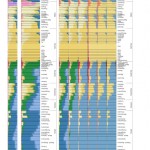
Ancient DNA from Mal’ta and Afontova Gora: A Full Account
Courtesy Alexander Kim, the long-awaited paper by the Eske Willerslev team became finally available to me. This is obviously not the last word on the subject of Amerindian origins, and the David Reich Lab has a different interpretation of ancient…
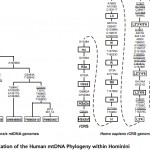
A Closer Look at Human and Neandertal Mitogenomes
In one of my comments on Anthrogenica.com, I mistakenly denied that Behar et al. (2012) reported the two mutations A2758G and G7146A shared between late European Neandertals and the modern human L2’3’4’5’6 clade. As a reminder, A2758G and G7146A were highlighted in…
The End of Out-of-Africa: A Copernican Reassessment of the Patterns of Genetic Variation in the Old World
Over at Anthrogenica, I’ve been having some heated (as always) but this time also productive discussions regarding the interpretation of currently available genetic evidence. In the following I will sketch out a hypothesis that increasingly makes sense to me. 1….
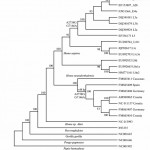
A Signal of Neandertal Admixture in Modern Human mtDNA?
Russian Journal of Genetics, September 2013, Vol. 49, No. 9, 975-978 Mitochondrial DNA Polymorphisms Shared Between Modern Humans and Neanderthals: Adaptive Convergence or Evidence for Interspecific Hybridization Malyarchuk, Boris A. Abstract An analysis of the variability of the nucleotide sequences in the…
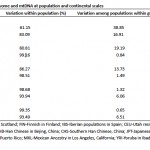
Molecular Variance Across Genetic Systems in Modern Humans and Their Kinship Structures
Gisele Horvat has kindly pointed me to this new pre-print. This post is cross-posted at www.kinshipstudies.org. Global patterns of sex-biased migrations in humans Chuan-Chao Wang, Li Jin, Hui Li. Abstract A series of studies have revealed the among-population components of…
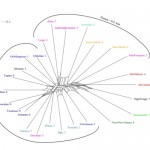
Stability vs. Diversity: A Novel Method for Analyzing Worldwide Linguistic Structures
PLoS ONE 7(9), 2012: e45198. doi:10.1371/journal.pone.0045198 Abstract Profiles of Structural Stability Point to Universal Tendencies, Family-Specific Factors, and Ancient Connections between Languages Dan Dediu, and Stephen C. Levinson Language is the best example of a cultural evolutionary system, able to…
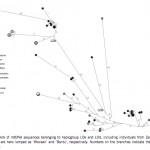
Intense Admixture: Khoisan Clicks and Khoisan Genes in Southeastern Bantu
European Journal of Human Genetics 2012, 1-7 DOI:10.1038/ejhg.2012.192 Genetic Perspectives on the Origin of Clicks in Bantu Languages from Southwestern Zambia Chiara Barbieri, Anne Butthof, Koen Bostoen, and Brigitte Pakendorf Some Bantu languages spoken in southwestern Zambia and neighboring regions…

mtDNA CR HVS1 16189
In the new paper on mtDNA lineages in the populations of Patagonia and Tierra del Fuego, de Saint Pierre et al. (2012) published several new D1 sequences from this region of South America. Among them D1g2 and D1g1 are interesting…
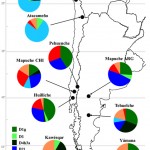
mtDNA from the South Cone of South America
PLoS ONE 7(9): e43486. doi:10.1371/journal.pone.0043486 An Alternative Model for the Early Peopling of Southern South America Revealed by Analyses of Three Mitochondrial DNA Haplogroups Michelle de Saint Pierre, Claudio M. Bravi, Josefina M. B. Motti, Noriyuki Fuku, Masashi Tanaka, Elena…
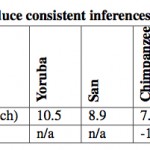
How Europeans Got to Be ~10% American Indian
Genetics doi: 10.1534/genetics.112.145037 Ancient Admixture in Human History Nick Patterson, Priya Moorjani, Yontao Luo, Swapan Mallick, Nadin Rohland, Yiping Zhan, Teri Genschoreck, Teresa Webster, and David Reich Population mixture is an important process in biology. We present a suite of methods…
Novel mtDNA and Y-DNA Haplogroups and Polymorphisms in South American Indians
DNA in Forensics 2012, Sep 06-08 2012 Below are some of the more interesting findings related to New World genetics reported at the recent “DNA in Forensics 2012” conference held at the University of Innsbruck, Austria (via Dienekes). The detection…
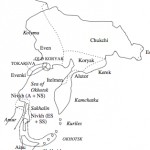
Nivkh and Chukotko-Kamchatkan Linguistic Relationship and Its Genetic Correlates
Lingua Vol. 8, Issue 121, June 2011, 1359-1376 http://dx.doi.org/10.1016/j.lingua.2011.03.001 The Relationship of Nivkh to Chukotko-Kamchatkan Revisited Michael Fortescue With the availability today of reliable materials for comparing the languages that in the past have been lumped together under the rubric…
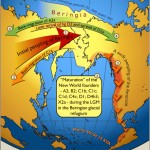
Dene-Yeniseian Language Family: Evidence for a Back-Migration to the Old World?
The 2012 Dene-Yeniseian Workshop took place on March 24 at the University of Alaska Fairbanks. Since the seminal presentation by the West Washington University linguist, Edward Vajda, of morphological and lexical evidence relating the small Yeniseian language family from Western…

mtDNA and Y-DNA Markers in South American Indians
Genetics and Molecular Biology 2012 Apr-Jun; 35 (2): 365-387. doi: 10.1590/S1415-47572012005000027. Uniparental Genetic Markers in South Amerindians Rafael Bisso-Machado, Maria C. Bortolini, and Francisco M. Salzano. A comprehensive review of uniparental systems in South Amerindians was undertaken. Variability in the…
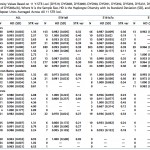
Genetics and Linguistics of the Bantu Expansion
Proc. Roy. Soc. Lond. B 279: 3256-3263. doi: 10.1098/rspb.2012.0318 Bringing Together Linguistic and Genetic Evidence to Test the Bantu Expansion De Filippo, Cesare, Koen Bostoen, Mark Stoneking, and Brigitte Pakendorf. The expansion of Bantu languages represents one of the most momentous…

Social Anthropology and the Bantu Expansion
Razib is now officially a fantasy science blogger. When he recently called his readers “stupid, ignorant or lazy” and put up a stringent comments policy (I bet inspired by my own) rallying them to show their “A-game,” I knew it…
A Seismic Shift in Human Origins Research, or a Downward Slide?
A new research paper is out which has created a lot of media buzz. “Evolutionary History and Adaptation from High-Coverage Whole-Genome Sequences of Diverse African Hunter-Gatherers, “ by Joseph Lachance et al. reports “archaic admixture” in three African hunter-gathering populations…
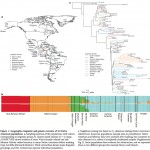
A Three-Wave Model for the Peopling of the Americas, or a Three-Wave Back-Migration from the Americas to the Old World
Nature (2012) doi:10.1038/nature11258 Reconstructing Native American population history Reich, David, et al. The peopling of the Americas has been the subject of extensive genetic, archaeological and linguistic research; however, central questions remain unresolved. One contentious issue is whether the settlement occurred…
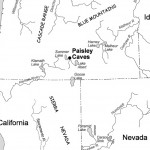
The Western Stemmed Tradition, Clovis and mtDNA 9-bp Deletion
Science 13 July 2012: Vol. 337 no. 6091 pp. 223-228 DOI: 10.1126/science.1218443 Clovis Age Western Stemmed Projectile Points and Human Coprolites at the Paisley Caves Jenkins, Dennis L. et al. The Paisley Caves in Oregon record the oldest directly dated human…

Howler Monkeys, Neandertals, Pygmies, Khoisans and More: Society for Molecular Biology and Evolution 2012
As I write, Society for Molecular Biology and Evolution (SMBE) is conducting its annual meetings in Dublin, Ireland. Dienekes has many useful pullouts from the available abstracts. I will make short comments on a few of them, plus bring in…

More on Amerindian mtDNA haplogroups X2, B2 and C4: Evidence from Siberian Tubalars, Tuvans, Evens and Ulchi
American Journal of Physical Anthropology Vol 148, No. 1, pages 123-138, May 2012 DOI: 10.1002/ajpa.22050 Mitochondrial Genome Diversity in the Tubalar, Even and Ulchi: Contribution to Prehistory of Native Siberians and Their Affinities to Native Americans Sukernik, Rem I., Natalia V….
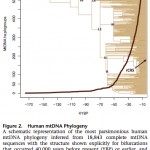
Between Behar et al. 2012 and Johnson et al. 1983: The Mitochondrial DNA Tree Comes of Age but Remains a Blunt Tool for Human Evolutionary History
American Journal of Human Genetics, Volume 90, Issue 4, 675-684, 6 April 2012 doi:10.1016/j.ajhg.2012.03.002 A “Copernican” Reassessment of the Human Mitochondrial DNA Tree from its Root Behar, Doron M., Mannis van Oven, Saharon Rosset, Mait Metspalu, Eva-Liis Loogvali, Nuno M….
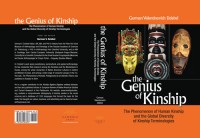
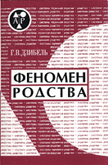
Recent Comments